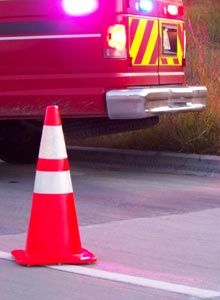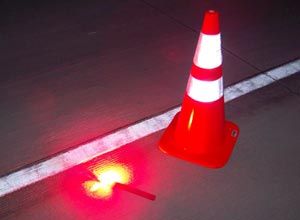By Ron Moore
Chief Instructor, Emergency Responder Safety Institute
“Engine 604 is Out, I have a Two Vehicle Collision…"
You’ve arrived at the crash scene on the divided highway in your district with the other firefighters on your crew. It looks at first glance like a serious crash. The two civilian vehicles are on the left side of the road and the left lane is obstructed. A police department vehicle is on scene. The blue four-door civilian vehicle in front of you has occupants still in it and looks like it is up against the guardrail. It’s hard to tell if anyone is still in the smashed up SUV that is in the grass median.
As the fire department officer in charge, you call your communications center, give your arrival report, and establish Command. Your driver places the apparatus in the left lane of the roadway and positions in a ‘block to the right’ position to shut down the left shoulder and the left lane. You and your firefighters get out of the rig with your helmet and protective gear already donned. Your high-visibility vest is on over your turnout coat. As you conduct your walk-around size-up of the crash scene, you do a face-to-face with the police officer who arrived ahead of you. In his quick report to you, he states that he’ll need help with traffic control.
Based on your experience and what you discover during your scene assessment, you’ll need hazard control work to be completed on both vehicles and you’ll have at least one if not two injured patients to transport. If everything goes as planned and the tow truck that has been called can get here through the backup of traffic, you’ll be out of here in about 35 minutes; maybe more.
So how do we set up our initial traffic control measures? As firefighters, this is becoming a more and more common task and something we must address. Safe and efficient traffic incident management is the responsibility of all responders on-scene. Everyone’s actions must support the safety of responders and those motorists involved in the incident, as well as safety for those motorists who only want to go past us and get on with their travels.
In our scenario, we’ve described an incident on a divided highway with two lanes of traffic in each direction separated by a center grassy median and a concrete divider barrier wall. There are shoulders on both the left and right side of the travel lanes.
 To deploy this final cone of a five cone ‘taper’ set up, the responder walked out from the side of the lane of traffic, placed the cone, and immediately returned to the relative safety of the side of the roadway. Do not walk the lane as you deploy cones or flares. |
“Driver 604, this is Command. I need you to deploy cones to move traffic to the right lane. We’ll move traffic past us in that open lane.” The expectation is that your driver will be able to take the five cones that are on the side running board of the engine and use them appropriately. In fact, you expect him to not only set up the cones so traffic merges to the right, but you also expect him to be safe while he’s doing it. You have other things to do and just have to believe that the assignment will be fulfilled without any problems.
This is where the model cone deployment guideline comes into play. Long before you got to this crash scene, you and all your personnel should have received training in what is and what isn’t proper to do when cones or flares are being deployed.
Adopting a guideline on how you want this task to be accomplished by your firefighters is fast becoming an accepted practice among departments large and small. With a guideline developed that meets your specific conditions, training can then be put in place and the risk/management aspect of this high-risk action can be addressed.
Best practice procedures
It sounds simple; take these five cones, walk up the highway, and set them up in a diagonal line. But to be safe and for the message these cones are designed to convey to be apparent to the approaching motorist, there are some best practice procedures that can be considered.
The model deployment guideline works for all types of road where either cones or highway flares have to be deployed as a temporary traffic control measure. The guide focuses on the number five because that is the number of traffic cones required to be provided on NFPA 1901-compliant fire apparatus since January this year. In reality, if this were a road construction work zone project and not a crash scene, there may be cones, signs, arrowboards, and other traffic control devices covering a distance upstream of hundreds of feet up to several miles. This isn’t a scheduled work zone; it’s an unplanned incident where temporary traffic control measures will be put into place by responders once we arrive on scene.
What is apparent about the recommendations within the model deployment guideline is that the safety of the person deploying the cones or flares is of utmost importance. The responder is accomplishing a very high-risk assignment; one where a single mistake or complacency for the risks involved can get one struck and killed.
‘Upstream’ point
As you study the deployment guideline, realize that the responder moves to the most ‘upstream’ point initially, carrying the stack of cones or the handful of flares as they walk along the shoulder. If you carry an NFPA-recommended pink “Emergency Scene Ahead” sign, it is deployed first and positioned along the shoulder so that approaching motorists see this first as they approach the scene.
 The Manual of Uniform Traffic Control Devices (MUTCD) requires that cones used at night or at incidents where the posted speed is greater than 45 miles per hour must be 28 inches tall with two reflective bands. MUTCD also recommends illuminating cones deployed at night by placing a road flare nearby. |
Note also that for the majority of the time the individual is upstream and outside of the protection of a blocking vehicle; the responder moves along the side of the travel lane being shut down, not within the lane. The only time the responder is actually in the lane of travel is when the actual cone or flare is being placed. The responder moves out from the side of the lane or shoulder area, places the warning device, and immediately returns back to the side of the lane.
When flares are being deployed, the responder must be trained that the flare is lit not while standing out in the lane of traffic but rather it is ignited on the side of the road prior to walking out into the travel lane.
Study this model guideline. Realize that it is only a starting point for you and your department and that deploying cones or flares is just one component of the total process of temporary traffic control. From this model document, you will be able to design your own customized procedural document; one that meets your needs and allows you to begin training your members in temporary traffic control device deployment.
 |
For questions on the content of this model deployment guideline or for assistance customizing this to suit the needs of your department, contact Ron Moore, Training Officer for the McKinney, Texas, Fire Department, directly by e-mail at Rmoore@mckinneytexas.org.











